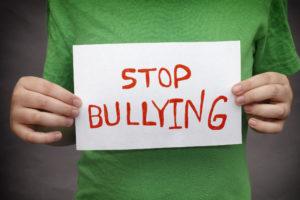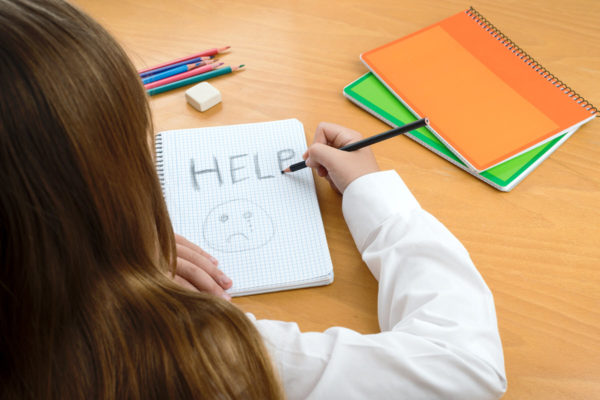Imagine being in the 7th grade again. The bus pulls up to your middle school, but you hesitate to get off. You’re tired from another restless night. Your stomach hurts at the thought of walking to your locker. It’s going to be another long day of trying to avoid trouble and get through gym and lunch unscathed. You’ve gone to teachers and even the principal, but nothing seems to work. You’re being bullied.
Unfortunately, many students don’t have to imagine that scenario — they’re living it. In one set of national statistics, 28 percent of students grades 6-12 said they had been bullied, approximately 30 percent had engaged in bullying, and about 70 percent of students and staff had witnessed bullying in their schools.
The impact of bullying, including increased anxiety and depression, difficulty sleeping and eating, and a range of social problems, are serious enough that many now consider it a public health problem.
“You talk to a person who’s 60, 70, 80 years old, and they remember their bullying experience as if it were yesterday,” says Yvonne Cook, president of the Highmark Foundation.
Since 2007, the Highmark Foundation has operated the Bullying Prevention Institute as a way to support efforts to prevent bullying in schools. Cook says it’s appropriate to compare bullying with other public health problems.
“Think about diabetes — that’s a public health concern with serious impacts, and we’ve embraced the idea that our schools and communities now have a responsibility to educate people on the importance of diet and exercise as well as the dangers of the disease,” she explains. “The same model can be applied to bullying — we want to help schools and communities find strategies to stop bullying before it starts.”

One obstacle to overcoming bullying is that people don’t always notice that it is happening. Others deny how damaging bullying is, framing it as “just kids being kids” or an experience that will “toughen up” a child. Such mindsets allow bullying to spread like a disease that is left untreated.
In some cases, bullying may overlap with protections provided under civil rights laws, including if students are being bullied due to their race, ethnicity, and/or nationality; sexual orientation or gender identity; religion; or physical abilities. And many teachers and administrators certainly understand the seriousness of bullying in general — in Pennsylvania the law requires every school to have a bullying prevention policy.
While laws and policies are important, there is still the challenge of applying and enforcing them effectively — and getting at the root causes of why bullying occurs in the first place.
That’s where the Highmark Foundation’s Bullying Prevention Institute, and partners like the Center for Health Promotion and Disease Prevention (CHPDP) and the Center for Safe Schools (CSS) are working to make a difference. CHPDP’s work includes bullying prevention education training for pediatricians, health care providers and community-based organizations, school-based health programs and mental health trainings, and much more. CSS partners with the Pennsylvania Department of Education and other organizations to educate the public on bullying prevention and other issues impacting students, and offers a range of resources, including, in partnership with the Highmark Foundation, a downloadable bullying prevention toolkit.

“Bullying continues to be a significant public health issue, but by continuing to invest in organizations that have effective resources, and can give technical assistance to aid schools, parents, and children, we can make tremendous progress,” Cook says. “The Bullying Prevention Consultation Line was an example where, as we kept doing our work in Pennsylvania, we identified a gap in terms of there not being a central line for parents, and schools and children to get help. So we worked together to fill that gap.”
Michelle Nutter, a certified Pennsylvania teacher, and CSS’s Safe and Supportive Schools program manager adds that, “When you’re in prevention work, our goal ultimately is to put ourselves out of business. Hopefully we’ll see a day when bullying is thought of as something they used to do back in 'the old days.'” She compared bullying prevention to past public health efforts like getting everyone to wear seatbelts. “It’s become rare to see a young person who doesn’t buckle up, because of all the messaging and information dedicated to teaching seatbelt use among young people,” she explains. “At some point, we hope that’s where we are with bullying prevention — that our methods aren’t needed anymore because they’ve become ingrained in our way of treating each other.”
Over the last decade, the approach to bullying has shifted from being primarily about awareness (what bullying is, why it’s important) and intervention to understanding why it occurs and taking proactive steps to make it less likely to occur.
“The conversation has evolved more into ways we can help children interact positively with each other,” Nutter says. “It’s not so much about bullying being the bad thing we want to fix, but instead focusing on good skills we can teach kids. We talk about socioemotional learning — helping kids to understand their emotions, and how their emotions, how they interact, what they choose to say or not say, can impact relationships with others.”
Evidence suggests that simply punishing a bully does little to prevent future incidences. The social and emotional learning approach is more holistic — it looks at the big picture of childhood development and gives students the frameworks and communication tools to understand and manage their emotional responses, handle stress and conflict, and choose positive ways of interacting with others. Instead of reacting to bullying behavior, the goal is to prevent the kinds of thinking and emotional reactions that can lead to bullying. For example, one basic idea is for kids to learn that it’s okay to not always get their own way.
“The bottom line is that we treat each other the way we would like to be treated — we treat others with dignity and respect, and it doesn’t matter if you’re the teacher in front of the classroom or one of the students,” Nutter says. “We all have that responsibility to be kind to each other.”
If you or someone you know is being impacted by bullying and aren’t sure what to do, there are many good organizations and resources to help. In Pennsylvania, you can call the Bullying Prevention Consultation Line at 1-866-716-0424, 24 hours a day, seven days a week. Also be sure to check out resources on the websites of the organizations mentioned in this article: